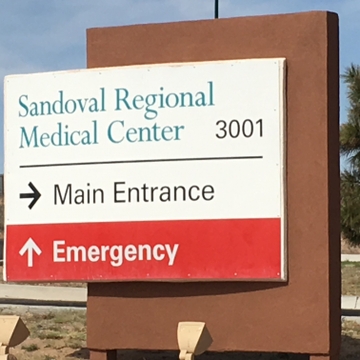Preparing for Disaster: UNM Hospital Participates in Region-Wide Emergency Training

Sandoval County Regional Center ER Provides Benefits, Saves Money throughout the County
First responders in Sandoval County's wide-open spaces say every 911 ambulance call creates a situation akin to a game of chess.
In a county larger than Rhode Island - and where the next medical facility can be 150 miles away - the question looms large: if an ambulance is sent from Bernalillo to Cuba or Jemez Springs, then who can stand in for Bernalillo in case of they have an emergency before their ambulance returns to home base?
"There is a huge void for health care services in rural areas, and we know we are the closest medical destination to a large area of Sandoval County," says Andrew Bartkus, director of the Sandoval County Medical Center (SRMC) Emergency Department.
If the November 6 mill levy passes, the additional funding will allow the hospital to keep pace with the demand from the growing metropolitan sector while providing rural first responders and patients with additional emergency services.
"Our location can provide a significant savings in time to people coming in from rural areas," Bartkus says.
Saving time can save lives.
The hospital, on the north end of Rio Rancho with a direct path to US 550, is positioned on the boundary between the metroplex and rural Sandoval County. It means the department can see traumas from both worlds. A day in the ER holds the potential to see cases ranging from industrial accidents occurring in the city to ranch hands brought in by family after a tractor accident.
The hospital's opening in 2012 "made ambulance transport a whole different ballgame," Cuba Ambulance director Myra Sande says.
Her company - the only Public Regulation Commission-qualified ambulance service in the northern sector along US 550 - saw total roundtrip times drop from 4 to 6 hours to transport a patient to Albuquerque to 3 1/2 hours for an arrival and treatment at SRMC.
"The downtown Albuquerque hospitals are so busy that our staff can face up to a two-hour wait to have a patient admitted to an ER," she says. "Being able to admit people to SRMC means they can be back in service in their hometown that much quicker."
The hospital's presence has also meant savings in time and manpower for the county, according to Sandoval County Fire Chief James Maxon. "Without the hospital expansion into Sandoval County, we probably would have had to increase our staff by one-third," he says.
Much of Sandoval County's fire protection remains a volunteer system, Maxon says, and only two of the county's 20 stations are open 24/7, with the other 18 staffed on an on-call basis. Being able to keep ambulances inside the county limits means more time with vehicles housed at their home base. The difference in mileage also has added up to savings in maintenance costs and the wear and tear on vehicles, he says.
Having SRMC as an integral part of the UNM Health System provides added benefit to the county, according to Bartkus, and it also allows for greater coordination of trauma care. For example, the majority of patients sent to a hospital after a widely publicized bus accident on I-25 this summer were received and treated at SRMC, Bartkus says.
If the November 6 mill levy passes, the top priority for the funds that are generated will be to expand emergency services to have SRMC house a Level III trauma center, Bartkus says.
"It will provide us with a more structured response to trauma care," he says. "The biggest benefit will be in our operating room, with surgeons and anesthesia physicians within 30 minutes of a trauma arrival."
Bartkus adds that SRMC has seen some significant trauma cases brought in directly by friends and relatives of the patients who didn't believe they had the time to wait for an ambulance.
But not all walk-ins are trauma cases - and many have very happy conclusions for all concerned, he says. "Even though we don't have a labor and delivery program, we have had several childbirths in the ER and we have successfully treated patients who were in full cardiac arrest," he says.
Meanwhile, the hospital's commitment to Sandoval County will continue to grow as its emergency services evolve to keep pace with population growth.
"We have had phenomenal growth in the past few years," he says. "In some years, we experienced 20 percent growth, and last year we had some 24,000 patient visits."